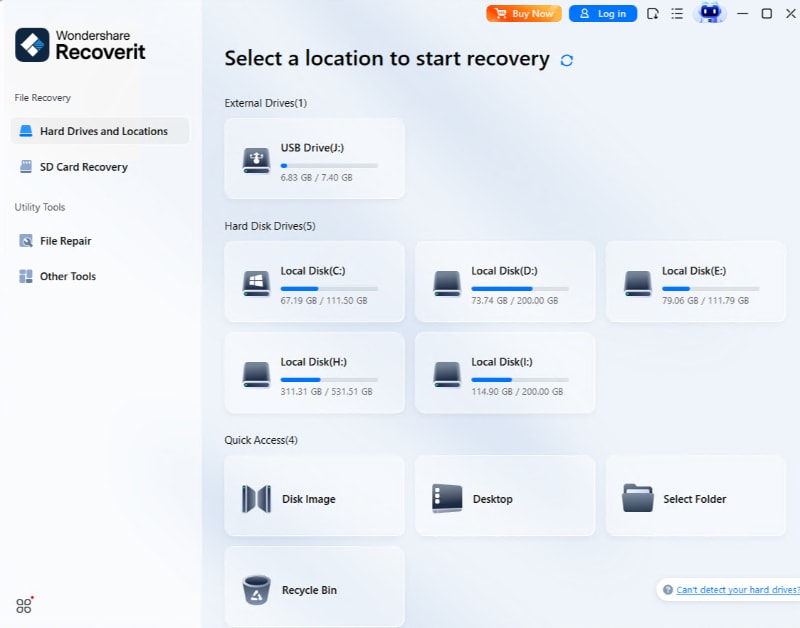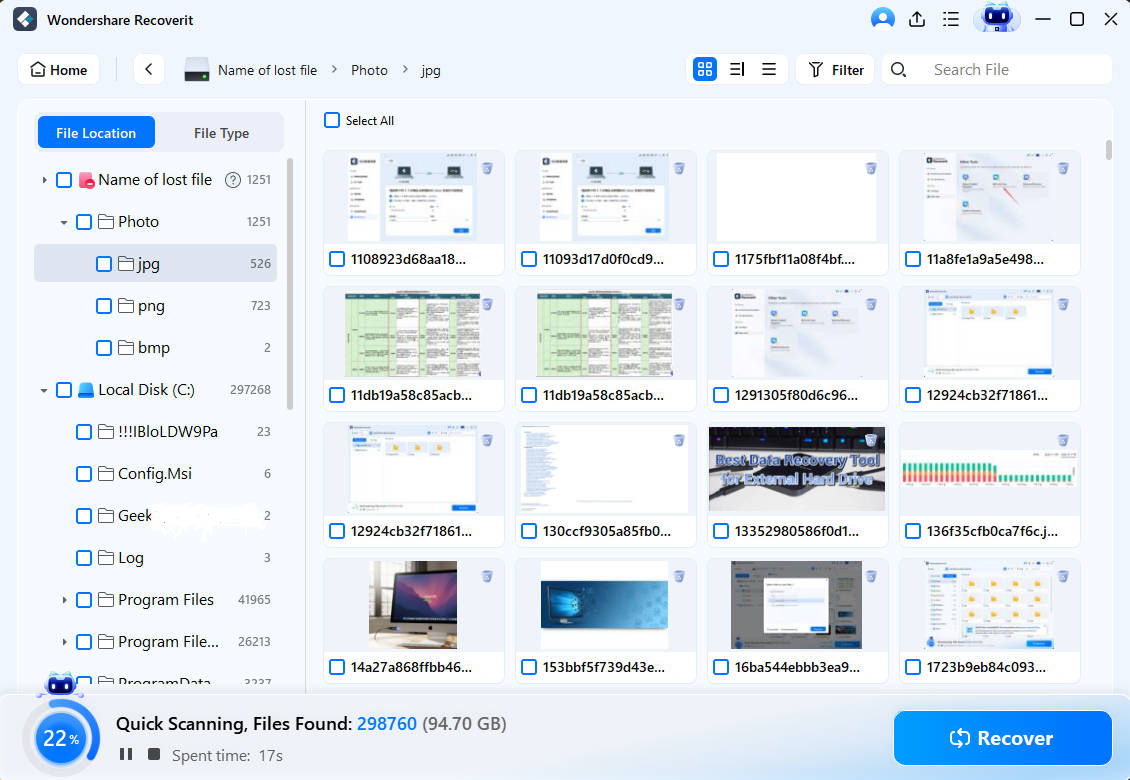C drive full for no reason? This problem hits many Windows users daily. You try to save a file, but Windows shows that red bar. The local C drive full message pops up. Panic sets in.
The local disk C full issue stops your PC from working well. Apps crash. Windows slows down. Even basic tasks take forever. Your computer feels broken, but it's just out of space.
Many face the C drive is full but nothing to delete problem. You look at your files and see nothing big. Where did all your space go?
This guide will solve your full local disk C headaches fast. We'll find what's eating your space. Then we'll show you how to clear it. After reading, you'll fix your C drive full for no reason issue for good.
Try Recoverit to Recover Lost C Drive
Security Verified. Over 7,302,189 people have downloaded it.
In this article
Part 1: Why C Drive Full For No Reason?
Wondering why my C drive is full without reason on Windows 11? Your disk space doesn't just vanish. Hidden files and system processes take it up. Let's uncover why your C drive is full when you can't see why:
- Windows Update creates backup files that stay after updates finish
- System Restore points can take up 5-15GB without you noticing
- Temporary internet files grow bigger every day you browse
- Program cache files expand over time, especially from media apps
- App installers remain after installation completes
- Windows keeps old system files after major updates "just in case"
- Page file (virtual memory) can grow to several GB
- Shadow copies store previous versions of files you've changed
- Unwanted programs running in the background create log files
- Downloaded Windows Store apps you forgot about
Part 2: Quick Solutions: Fix C Drive is Full Issue?
When your local C disk full warning appears, you need solutions fast. Windows has built-in tools to help. Each fix targets different space-wasting culprits.
Don't worry about technical skills. These fixes work for beginners, too. Follow them in order for the best results with your full local disk C issue.
Fix 1: Run the Disk Cleanup Tool
The Disk Cleanup tool helps solve the C drive is full for no reason problem quickly. Microsoft built this tool to find and remove safe-to-delete files. It works on both Windows 10 and 11 systems.
Disk Cleanup locates outdated logs, temporary files, and cached data, swiftly reclaiming multiple gigabytes of storage in just minutes. It's a quick and effective fix for a cluttered C drive, often resolving a significant portion of the issue instantly.
Let’s learn fixing the C drive is full and how to free up space:
- Click Start and type "Disk Cleanup". Select Disk Cleanup. Choose your C: drive if asked. Wait for the scan to finish. Check all boxes in the list. Click the Clean up system files
- Check new boxes that appear, especially "Windows Update Cleanup". Click OK to delete the files. Confirm when prompted
Fix 2: Empty the Recycle Bin
Many don't realize that the Recycle Bin keeps all deleted files.
The Recycle Bin can hold gigabytes of files. If you haven't emptied it in months, this could be your main local C disk full culprit.
Steps:
- Find the Recycle Bin icon on your desktop. Right-click the icon. Select "Empty Recycle Bin".
- Click Yes to confirm. Wait for the process to complete
Fix 3: Uninstall Unused Programs
Unused programs take up valuable space, contributing to unexpected C drive storage issues on Windows 11. Games, editing software, and outdated applications can occupy significant storage, often leading to a cluttered system.
Removing unused programs frees up space fast. Look for large programs you installed months ago but never use now.
Steps:
- Press Windows key + I to open Settings. Click on "Apps" then "Installed Apps”. Set the sort order to "Size" to see the biggest programs. Click on programs you don't use. Click the "Uninstall" button.
- Follow the uninstall wizard. Repeat for all unused programs. Restart your computer when done
Fix 4: Delete Temporary Files
Temp files build up every day, causing local C drive full issues. Your PC creates these files during normal use. They should delete automatically but often don't.
These files hide in special folders. Most users never see them. But they can take up 10+ GB of space.
Steps:
- Press Windows key + R. Type "%temp%" and hit Enter. Press Ctrl+A to select all files. Press the Delete key.
- Empty the Recycle Bin afterward. Now type "temp" in the Run box. Delete files in this folder too. Type "prefetch" in the Run box. Delete files in the prefetch folder
Fix 5: Scan for Viruses or Malware Using Windows Security App
Malware often causes C drive is full but nothing to delete problems. Bad programs hide files or create junk data. They fill your drive secretly.
Running a full virus scan can find and remove these space-wasters.
Steps:
- Click Start and type "Windows Security". Open the Windows Security app. Click "Virus & threat protection". Click "Scan options". Select the "Full scan" option.
- Click the "Scan now" button. Wait for scan to complete (can take hours). Remove any threats found. Restart your computer
Fix 6: Clear Browser Cache
Web browsers store tons of data as you surf. Images, videos, and site data pile up in your cache.
Clearing this cache frees space without affecting your browsing much. All major browsers have similar cleaning options.
Steps:
- Open your main web browser. Find Settings (usually three dots in corner). Look for Privacy or History section. Find "Clear browsing data" option. Select "Cached images and files."
- Choose "All time" for time range. Click the "Clear data" button. Repeat for other browsers you use. Restart the browser
Fix 7: Disable Hibernation
Hibernation saves your work when you shut down. But it creates a huge file equal to your RAM size. This causes local C disk full problems.
If you don't use hibernation, turn it off. This can free 4-32GB instantly depending on your RAM.
Steps:
- Click Start and type "Command Prompt". Right-click Command Prompt and select "Run as administrato.r". Type "powercfg.exe /hibernate off" and press Enter.
- Close Command Prompt. The hibernation file disappears instantly
Fix 8: Move User Folders to Another Drive
Your Documents, Pictures, and Downloads folders fill up fast. Moving them helps fix C drive is full but nothing to delete issues.
This keeps your files but stores them on a different drive. Your programs still find them normally.
Steps:
- Connect another drive to your PC. Open File Explorer. Right-click your user folder (Documents, Pictures, etc.). Select "Properties". Go to the "Location" tab. Click the "Move" button.
- Browse to a new location on a different drive. Click "Apply" then "Yes" to move files. Repeat for other user folders
Part 3: Lost Important Files on C Drive? Use Recoverit Tool Today
When fixing your C drive full for no reason problem, accidents happen. Important files get deleted. The Recoverit tool rescues these lost files quickly.
Recoverit stands out among recovery tools for its high success rate. When your local C drive full, panic leads to mistakes, this software saves the day. It works even after formatting or disk cleanup.
The tool recovers over 1000 file types. Photos, videos, documents—all come back intact. When facing C drive is full but nothing to delete issues, data safety matters most.
Steps to use Recoverit:
- Download Recoverit. Install on a drive other than C (to avoid overwriting). Launch the program. Select the C drive as your target. Click "Start" to begin deep scanning.

- Wait for the scan to complete. Preview found files by clicking thumbnails.

- Check boxes next to files you want back. Click the "Recover" button. Save to a different drive (very important). Wait for recovery to finish.

Part 4: Tips to Avoid the "c drive is full but nothing to delete" Issue
Prevention beats cleanup when dealing with full local disk C problems. Follow these tips to keep your drive spacious year-round:
- Install new programs to the D: drive or other drives by default
- Set up automatic Disk Cleanup to run weekly
- Move media files (photos, videos, music) to external storage
- Enable Storage Sense in Windows Settings for automatic maintenance
- Uninstall apps right after you stop using them
- Use streaming services instead of downloading movies and shows
- Store documents in cloud services like OneDrive or Google Drive
- Disable hibernation if you never use it
- Reduce System Restore space allocation to 5% of the drive
- Use portable apps that don't need installation when possible
- Clean browser cache weekly if you browse heavily
Conclusion
The C drive is full for no reason problem hits most Windows users eventually. Now you know it's not really "for no reason." Hidden files, system processes, and everyday computer use fill your drive slowly.
With the fixes in this guide, you can solve any local C drive full issue fast. Start with Disk Cleanup for quick wins. Then move to more advanced solutions as needed. Your computer will thank you with better performance.
Preventing C drive is full but nothing to delete problems saves time. Set up regular maintenance. Move big files to other drives. Use cloud storage when possible. Small habits prevent big headaches.
Remember that your local C disk full problem has solutions. Don't panic when you see that red storage bar. Just follow this guide step by step. Your C drive full without reason on Windows 11 problem will vanish faster than you think.
Try Recoverit to Recover Lost C Drive
Security Verified. Over 7,302,189 people have downloaded it.
FAQ
-
Why does my C drive keep filling up even after cleaning?
Your C drive full for no reason might be due to fast-growing system logs or Windows Update files. Check for runaway processes using Task Manager's Performance tab. Sort by disk usage to find the culprit. Some apps create huge log files that fill drives quickly. -
Is it safe to delete Windows.old folder to fix local C drive full issues?
Yes! The Windows.old folder holds your previous Windows version after an upgrade. It's safe to remove once you're sure your new Windows works well. This folder can take 15-20GB. Use Disk Cleanup and check "Previous Windows installations" to remove it safely when fixing local C disk full problems. -
How do I move my installed programs to another drive without reinstalling?
You can't simply drag program folders to fix C drive is full issues. Most programs write registry entries pointing to their installation location. Use a tool like EaseUS Todo PCTrans to move programs properly. For new installs, always choose a different drive during setup to prevent C drive full for no reason problems.



 ChatGPT
ChatGPT
 Perplexity
Perplexity
 Google AI Mode
Google AI Mode
 Grok
Grok























